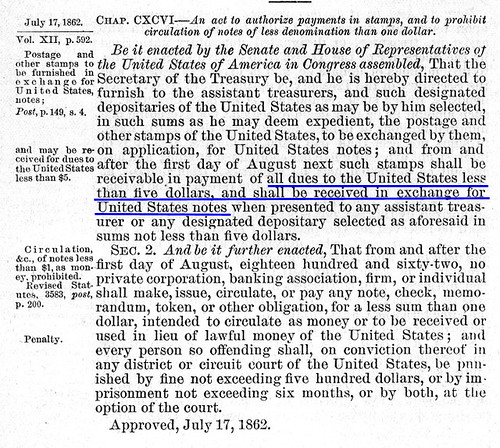
PREV ARTICLE
NEXT ARTICLE
FULL ISSUE
PREV FULL ISSUE
QUERY: PREMIUMS PAID FOR POSTAGE AND FRACTIONAL CURRENCY
Peter Huntoon submitted this query. Interesting topic! Can anyone help?
-Editor
I've been engaged in a most interesting and lively exchange with Fred Reed pertaining to postage currency, and its distinction from later issues of fractional currency. To that end, I am attaching the law authorizing postage currency and some contemporary accounts that Fred has compiled from his exhaustive research for his forthcoming book on Civil War money. The attached law is clear that postage currency could be tendered in amounts up to $5 per transaction for customs taxes, which otherwise had to be paid in gold, but otherwise postage currency was redeemable in legal tender notes. My question is if any of your readers have found either Treasury tables or bank note reporter quotations that differentiate between premiums paid for postage currency and fractional currency? If so, those findings may well reflect that the currency exchange market was willing to pay a premium for postage currency because even in a small amounts it was as good as gold for paying customs taxes. Clearly the data Fred has found reveals that significant premiums were being paid for postage currency during the initial period when it was in short supply and that it was actively being hoarded. It certainly was a major convenience for making change in comparison to handling postage stamps with their sticky gum and tiny size. To date the tables and quotes I have seen do not distinguish between postage currency and fractional currency, but instead lump them together and value them the same as legal tender notes. I must admit that I don't have much in the way of these data at my fingertips from early during the Civil War, so I may be blind to all the appropriate early Civil War data. I ran this issue by Dave Bowers who also has an interest and expertise in Civil War era currency, and he suggested forwarding it along to your readers, which seems like an excellent idea.
Below is the copy of the authorizing Act, followed by a couple example contemporary accounts.
-Editor

There are too many accounts to republish here, but I've selected a couple.
-Editor
So scarce were these notes in the Queen City, that Postage Currency was being sold at 5 to 10 percent premium by the city's bankers. "To exchange a dollar bill," one of the local newspapers complained, "you must lay it nearly all out." Large firms brought in large quantities of the Postage Currency from the East, but even they paid it out at 12.5 to 15 percent advances. These notes were no help to change-strapped public. A frustrated customs collector, Enoch Carson, who was responsible in the public's eye for the derangement in supplies was forced to put up a large sign: "NO MORE Postal Currency At Present. Until more comes, no use making Inquiry." His sign was up more often than not, adding to the public's frustration.
CURRENCY AT A PREMIUM. -- We respectfully call the attention of our money-making friends, whose working store they are seeking to augment by demanding a premium on the newly-issued postage currency, to the section No. 195 of the act of March 3, 1835, as follows: [It shall not] be lawful for any Postmaster, or other person, [to sell] postage stamps for any larger [sum than] indicated upon the face, and any person [violating] this provision, shall be esteemed guilty of a misdemeanor, and on conviction thereof shall be [fined a] sum not exceeding $500," the Times reported September 19th. Wayne Homren, Editor The Numismatic Bibliomania Society is a non-profit organization promoting numismatic literature. See our web site at coinbooks.org. To submit items for publication in The E-Sylum, write to the Editor at this address: whomren@gmail.com To subscribe go to: https://my.binhost.com/lists/listinfo/esylum All Rights Reserved. NBS Home Page Contact the NBS webmaster 
|